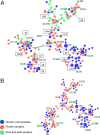A Population-Based Surveillance Study of Shared Genotypes of Escherichia coli Isolates from Retail Meat and Suspected Cases of Urinary Tract Infections
- PMID: 30111626
- PMCID: PMC6094058
- DOI: 10.1128/mSphere.00179-18
A Population-Based Surveillance Study of Shared Genotypes of Escherichia coli Isolates from Retail Meat and Suspected Cases of Urinary Tract Infections
Abstract
There is increasing evidence that retail food may serve as a source of Escherichia coli that causes community-acquired urinary tract infections, but the impact of this source in a community is not known. We conducted a prospective, population-based study in one community to examine the frequency of recovery of uropathogenic E. coli genotypes from retail meat samples. We analyzed E. coli isolates from consecutively collected urine samples of patients suspected to have urinary tract infections (UTIs) at a university-affiliated health service and retail meat samples from the same geographic region. We genotyped all E. coli isolates by multilocus sequence typing (MLST) and tested them for antimicrobial susceptibility. From 2016 to 2017, we cultured 233 E. coli isolates from 230 (21%) of 1,087 urine samples and 177 E. coli isolates from 120 (28%) of 427 retail meat samples. Urine samples contained 61 sequence types (STs), and meat samples had 95 STs; 12 STs (ST10, ST38, ST69, ST80, ST88, ST101, ST117, ST131, ST569, ST906, ST1844, and ST2562) were common to both. Thirty-five (81%) of 43 meat isolates among the 12 STs were from poultry. Among 94 isolates in the 12 STs, 26 (60%) of 43 retail meat isolates and 15 (29%) of 51 human isolates were pan-susceptible (P < 0.005). We found that 21% of E. coli isolates from suspected cases of UTIs belonged to STs found in poultry. Poultry may serve as a possible reservoir of uropathogenic E. coli (UPEC). Additional studies are needed to demonstrate transmission pathways of these UPEC genotypes and their food sources.IMPORTANCE Community-acquired urinary tract infection caused by Escherichia coli is one of the most common infectious diseases in the United States, affecting approximately seven million women and costing approximately 11.6 billion dollars annually. In addition, antibiotic resistance among E. coli bacteria causing urinary tract infection continues to increase, which greatly complicates treatment. Identifying sources of uropathogenic E. coli and implementing prevention measures are essential. However, the reservoirs of uropathogenic E. coli have not been well defined. This study demonstrated that poultry sold in retail stores may serve as one possible source of uropathogenic E. coli This finding adds to a growing body of evidence that suggests that urinary tract infection may be a food-borne disease. More research in this area can lead to the development of preventive strategies to control this common and costly infectious disease.
Keywords: Escherichia coli; extraintestinal diseases; molecular epidemiology; multidrug resistance; multilocus sequence typing; urinary tract infection; uropathogenic E. coli.
Copyright © 2018 Yamaji et al.
Figures




References
-
- Schappert SM, Rechtsteiner EA. 2011. Ambulatory medical care utilization estimates for 2007. Vital Health Stat 13:1–38. - PubMed
Publication types
MeSH terms
LinkOut - more resources
Full Text Sources
Other Literature Sources
Medical
